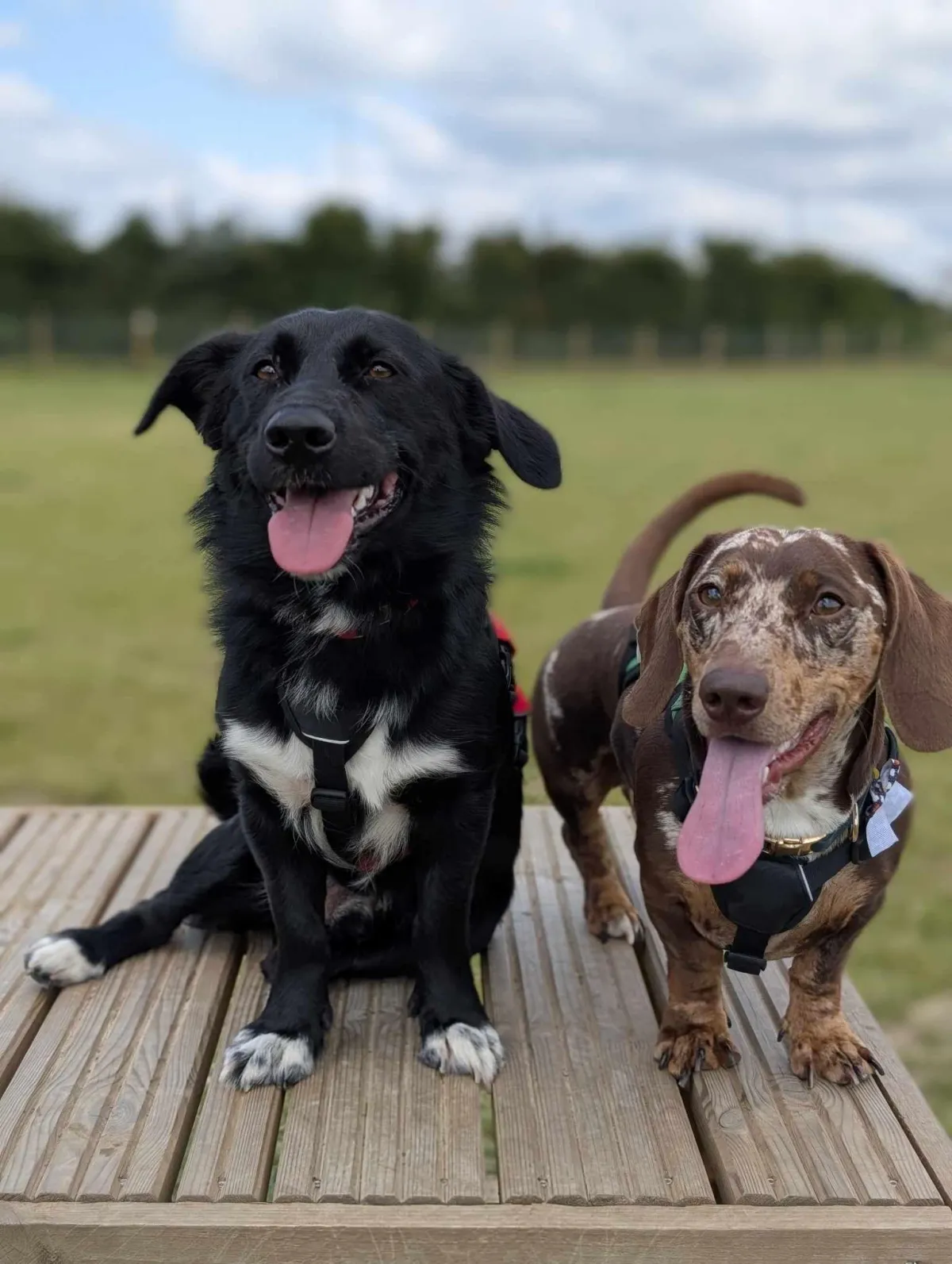Rescue Behavioural Consultant & Experienced Dog Trainer in Thurrock, Essex
⭐️⭐️⭐️⭐️⭐️ 100% 5-Star Reviews from Happy Dog Owners
Rescue Behavioural Consults & Dog Training in Thurrock, Essex
Personalised Training and Behaviour Support for You and Your Dog!
🌟 Trusted By Hundreds Of Dog Owners With High Success In Dog’s Behaviour!
🚶♀️🐕 Keep on top of your dogs training with ongoing support
throughout your programme!
🐾 Save Your £££ With Affordable Behavioural Assessment And Dog Training In Thurrock, Essex!
🌈 Enhance Wellbeing with Thorough Behaviour Assessments and Individualised Planning!

Samantha Wayland Dog Training Blog

When is it time to say goodbye to your elderly dog?
Saying Goodbye to Your Elderly Dog: Knowing When It's Time
In this blog, we explore one of the hardest decisions every pet owner may have to face: knowing when it’s time to say goodbye to an elderly dog. Unfortunately this is something that is very close to my heart as we had to make this decision ourselves only last week with our beloved 13 year old staffy Diefer.
As our beloved companions age, their needs change, and we find ourselves wondering how to balance their quality of life with our emotional attachment to them.
I believe it's something we need to talk about more even though it isn't easy. I'm hoping this blog offers compassionate advice, helps you recognise the signs that your elderly dog may be struggling, from physical discomfort to cognitive decline.
With insight drawn from my experience as a dog trainer and rescue advocate, I aim to guide you through this challenging process, offering support and practical tips to ensure that when the time comes, you can make the most compassionate decision 💚
As our dogs age their health can decline, and it’s natural to wonder if it’s time to let them go. While there’s no exact science that can tell you when it’s time to say goodbye, there are several signs and factors to consider that can help you make this deeply personal decision.
The biggest factor in deciding when to say goodbye is your dog's quality of life.
Age alone is not a reason to make this choice, but if your dog is in pain and are unable to enjoy everyday activities, it might be time to reflect.
Common indicators of a decline in quality of life include:
Difficulty moving or walking, even when you are helping. They may begin to stagger or seem unsteady on their feet.
Lack of interest in their once favourite activities, such as walks or playing
Chronic pain that medication cannot relieve, this is a hard one to see as they hide it so well but may involve lip licking, panting etc
Difficulty breathing, eating, or drinking
Frequent accidents or incontinence when they were previously toilet trained
Confusion or distress, especially when your dog once seemed confident and content
Dogs can’t tell you that they are in pain in words, but you know your dog’s personality and behaviour better than anyone. If you notice these signs, it’s important to discuss your observations with your vet. They can offer guidance on managing pain or conditions that may still be treatable, or they can help you consider humane options when your dog’s comfort is declining.
It’s also important to keep in mind that dogs are very good at hiding pain and discomfort. They may not show outward signs, but underlying conditions like arthritis, kidney failure, or heart disease can cause chronic suffering. Diefer went into kidney failure and the signs came on very suddenly. On the Saturday he ate a full dinner and his usual furry ear as a treat, by Sunday morning he no longer wanted to eat or drink. We knew it was bad when he wasn't even interested in a roast chicken dinner (and no my cooking isn't that bad!)
Most of us, myself included, struggle with the feeling that they are “giving up” on their pet. It’s normal to feel guilty or unsure, but remember, choosing to say goodbye is not a sign of failure. In many cases, it’s the most loving and humane decision you can make when your dog’s quality of life has deteriorated. I read once that it's better to say goodbye a day too soon than a day too late 💔
It can help to think about what your dog would want. Dogs live in the moment—they don't dwell on the future or reflect on their past. If they are no longer able to experience joy or comfort in their day-to-day life, it may be kinder to let them go peacefully rather than prolong their suffering.
If you have made the decision to say goodbye, it can be comforting to know that euthanasia is a gentle process. Most vets will allow you to be present, giving you the chance to say goodbye in a calm and peaceful environment. If possible, you might choose to have this done at home, where your dog feels most at ease. Whether you opt for a clinic or home euthanasia, take solace in knowing that you are providing a pain-free and dignified end for your dog.
Saying goodbye is incredibly painful, and it's normal to grieve deeply for your dog. Allow yourself time to mourn and remember the joyful moments you shared together. There is no right or wrong way to cope with the loss of a pet—everyone grieves differently. Whether you find comfort in keeping your dog's collar or favourite toy, creating a photo album, or planting a tree in their memory, or like me you want to write and try to ease other peoples pain in any tiny way that you can, honouring your dog’s life can help you heal.
Ultimately, the decision of when to say goodbye to your elderly dog is a personal one. Trust in your love for your dog and know that you have their best interests at heart. By focusing on their quality of life and seeking guidance from your vet, you can make the decision that will offer your dog peace and comfort in their final days.
I have 3 other dogs and they definitely sensed that Diefer was unwell. They didn't try to jump on him or encourage him to play. Like us they all reacted differently, our youngest dog is only 1 and he was very gentle, cuddling in and giving him gentle licks. Whereas our 5 year old Romanian rescue avoided him at all costs she couldn't look at him and wouldn't walk past him. We let them all say goodbye in their own ways and they certainly seemed to understand what was happening.
Remember our dogs grieve too, they may pace or search for their lost friend. We gave them extra attention and even more reassurance than usual and after a couple of days they settled into their new normal. In those days they could have as many treats as they needed.
There are some amazing dog grief counsellors out there so please if you are currently making this decision, don't feel you are alone. Reach out and I can help find the right person to help you 💚
This isn't the subject I planned for my first blog, but to be honest when I sit to write it's all I can think about.
RIP Diefer 💔

When is it time to say goodbye to your elderly dog?
Saying Goodbye to Your Elderly Dog: Knowing When It's Time
In this blog, we explore one of the hardest decisions every pet owner may have to face: knowing when it’s time to say goodbye to an elderly dog. Unfortunately this is something that is very close to my heart as we had to make this decision ourselves only last week with our beloved 13 year old staffy Diefer.
As our beloved companions age, their needs change, and we find ourselves wondering how to balance their quality of life with our emotional attachment to them.
I believe it's something we need to talk about more even though it isn't easy. I'm hoping this blog offers compassionate advice, helps you recognise the signs that your elderly dog may be struggling, from physical discomfort to cognitive decline.
With insight drawn from my experience as a dog trainer and rescue advocate, I aim to guide you through this challenging process, offering support and practical tips to ensure that when the time comes, you can make the most compassionate decision 💚
As our dogs age their health can decline, and it’s natural to wonder if it’s time to let them go. While there’s no exact science that can tell you when it’s time to say goodbye, there are several signs and factors to consider that can help you make this deeply personal decision.
The biggest factor in deciding when to say goodbye is your dog's quality of life.
Age alone is not a reason to make this choice, but if your dog is in pain and are unable to enjoy everyday activities, it might be time to reflect.
Common indicators of a decline in quality of life include:
Difficulty moving or walking, even when you are helping. They may begin to stagger or seem unsteady on their feet.
Lack of interest in their once favourite activities, such as walks or playing
Chronic pain that medication cannot relieve, this is a hard one to see as they hide it so well but may involve lip licking, panting etc
Difficulty breathing, eating, or drinking
Frequent accidents or incontinence when they were previously toilet trained
Confusion or distress, especially when your dog once seemed confident and content
Dogs can’t tell you that they are in pain in words, but you know your dog’s personality and behaviour better than anyone. If you notice these signs, it’s important to discuss your observations with your vet. They can offer guidance on managing pain or conditions that may still be treatable, or they can help you consider humane options when your dog’s comfort is declining.
It’s also important to keep in mind that dogs are very good at hiding pain and discomfort. They may not show outward signs, but underlying conditions like arthritis, kidney failure, or heart disease can cause chronic suffering. Diefer went into kidney failure and the signs came on very suddenly. On the Saturday he ate a full dinner and his usual furry ear as a treat, by Sunday morning he no longer wanted to eat or drink. We knew it was bad when he wasn't even interested in a roast chicken dinner (and no my cooking isn't that bad!)
Most of us, myself included, struggle with the feeling that they are “giving up” on their pet. It’s normal to feel guilty or unsure, but remember, choosing to say goodbye is not a sign of failure. In many cases, it’s the most loving and humane decision you can make when your dog’s quality of life has deteriorated. I read once that it's better to say goodbye a day too soon than a day too late 💔
It can help to think about what your dog would want. Dogs live in the moment—they don't dwell on the future or reflect on their past. If they are no longer able to experience joy or comfort in their day-to-day life, it may be kinder to let them go peacefully rather than prolong their suffering.
If you have made the decision to say goodbye, it can be comforting to know that euthanasia is a gentle process. Most vets will allow you to be present, giving you the chance to say goodbye in a calm and peaceful environment. If possible, you might choose to have this done at home, where your dog feels most at ease. Whether you opt for a clinic or home euthanasia, take solace in knowing that you are providing a pain-free and dignified end for your dog.
Saying goodbye is incredibly painful, and it's normal to grieve deeply for your dog. Allow yourself time to mourn and remember the joyful moments you shared together. There is no right or wrong way to cope with the loss of a pet—everyone grieves differently. Whether you find comfort in keeping your dog's collar or favourite toy, creating a photo album, or planting a tree in their memory, or like me you want to write and try to ease other peoples pain in any tiny way that you can, honouring your dog’s life can help you heal.
Ultimately, the decision of when to say goodbye to your elderly dog is a personal one. Trust in your love for your dog and know that you have their best interests at heart. By focusing on their quality of life and seeking guidance from your vet, you can make the decision that will offer your dog peace and comfort in their final days.
I have 3 other dogs and they definitely sensed that Diefer was unwell. They didn't try to jump on him or encourage him to play. Like us they all reacted differently, our youngest dog is only 1 and he was very gentle, cuddling in and giving him gentle licks. Whereas our 5 year old Romanian rescue avoided him at all costs she couldn't look at him and wouldn't walk past him. We let them all say goodbye in their own ways and they certainly seemed to understand what was happening.
Remember our dogs grieve too, they may pace or search for their lost friend. We gave them extra attention and even more reassurance than usual and after a couple of days they settled into their new normal. In those days they could have as many treats as they needed.
There are some amazing dog grief counsellors out there so please if you are currently making this decision, don't feel you are alone. Reach out and I can help find the right person to help you 💚
This isn't the subject I planned for my first blog, but to be honest when I sit to write it's all I can think about.
RIP Diefer 💔
Join Our Community Of Dog Lovers And Find What Your Dog Needs!
Come and connect with the Samantha Wayland Dog Training blog community where you can get up-to-date tips and tricks for your pet plans, and caring techniques for your dog. Learn the latest scientifically proven methods of how to train my dog, enhance your dog's behaviour, and transform your canine bond into an unbreakable one with expert tips and practical advice on pet care. Our community is a welcoming space for all to learn, share, and connect with people who share a love for dogs and find assistance in dog training. To enjoy heartwarming stories of companionship, expert tips from dog trainers, and to find a treasure of knowledge and inspiration, our blog is a go-to source for all things pet-related.
Want To Know More About Dog Training In Thurrock, Essex? Subscribe Now!
Subscribe to Our Daily Newsletter or Join Our Email List for Useful Tips and Tricks, Including
Discover our way to build connection with your dog.
Get free training tips for your dogs straight to your Mailbox.
Help and support your dog to be confident indoors and out.
Ready to elevate your dog's training and well-being?
To start working with us on one of our services or to learn more about our specialised dog training in Thurrock, Essex, simply fill out the contact form below.
Let's start a conversation about how we can support you and your dog.


